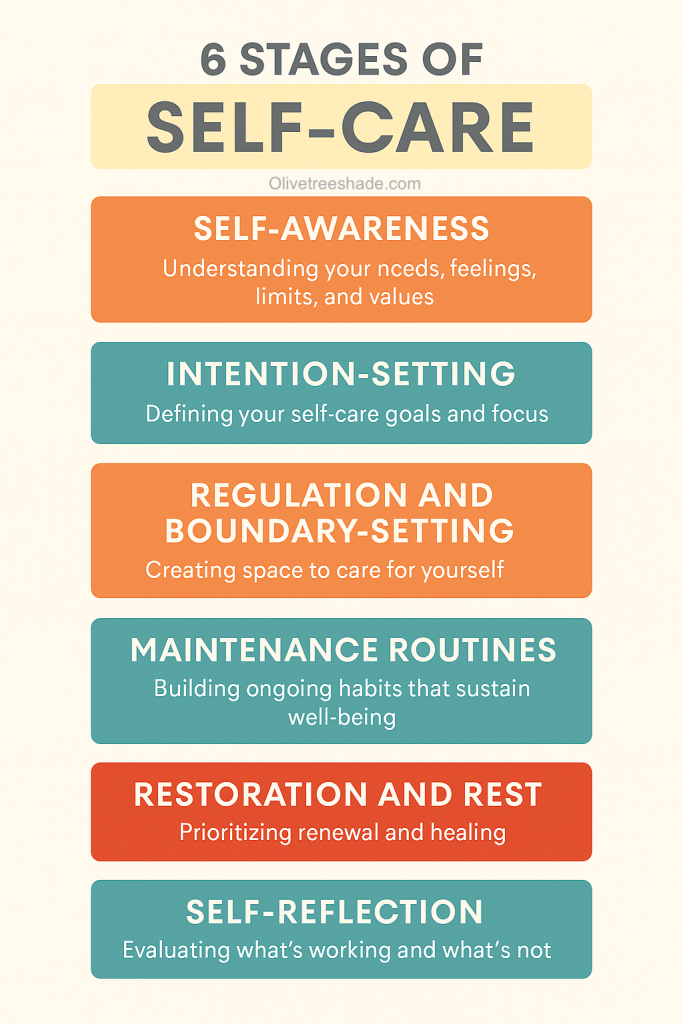Self-care is more than just taking time off or treating yourself. True self-care is a structured, ongoing process that begins with self-awareness and ends in self-reflection. Each step builds on the previous one, helping you create habits and choices that support your mental, emotional, and physical health. Below is a six-step model of self-care, including one simple example for each stage.
Step 1. Self-awareness
Understanding your needs, feelings, limits, and personal values. This is the foundation. Without awareness, self-care is often reactive or misdirected.
The first step in any effective self-care routine is self-awareness. This means noticing your emotions, energy levels, needs, and personal limits without judgment. When you’re self-aware, you can recognize what you need in the moment and make intentional choices. For example, you might realize that you feel anxious and irritable every afternoon—and that it usually happens when you skip lunch. This awareness is the foundation of smarter, more meaningful self-care decisions.
Step 2. Intention-setting
Defining what you want to focus on (health, balance, emotional clarity, energy, etc.). This is about purposefully choosing your self-care goals.
Once you’re aware of your needs, the next step is to set clear intentions. Intention-setting helps you define your self-care goals and align your actions with your values. Instead of drifting through the day reacting to stress, you’re choosing how to care for yourself on purpose. For instance, after noticing afternoon anxiety, you might set an intention to eat a balanced lunch every day—even if it’s just 15 minutes away from your desk. This small act reflects a conscious decision to prioritize your well-being.
Step 3. Regulation and boundary-setting
Creating and maintaining space to care for yourself—through emotional regulation, time management, and saying no when necessary.
To make self-care sustainable, you must protect your time, energy, and mental space. That means setting healthy boundaries and learning how to regulate your emotional responses. Without boundaries, your self-care efforts may quickly get interrupted or pushed aside. A real-life example might be telling a coworker, “I’m not available for meetings during my lunch break,” in order to preserve the intention you set. This boundary helps you stay committed without guilt or resentment.
Step 4. Maintenance routines
Building ongoing habits that support your physical, emotional, and psychological well-being. These are consistent actions, not one-time fixes.
Next comes the work of building consistent habits. Maintenance routines are the everyday practices that support your overall well-being. These don’t have to be dramatic; even small, repeated actions can have a big impact over time. For example, you might add a short 10-minute walk to your afternoon routine to boost energy and decompress after work. When done regularly, this becomes a part of your support system—not a chore.
Step 5. Restoration and rest
Prioritizing rest, renewal, and emotional reset. This step allows the system (your mind/body) to process, heal, and prepare for continued effort.
No matter how disciplined your routines are, you also need downtime. Restoration is the part of self-care that helps you reset—physically, mentally, and emotionally. Rest can take many forms, from sleep to play to silence. A simple example might be dedicating one evening a week to unplug from screens and read a book or take a bath. This kind of restorative time allows your nervous system to settle, preventing burnout and helping you recover from daily stress.
Step 6. Self-reflection
Evaluating what’s working, what’s not, and what you’ve learned. This step closes the loop and prepares you to adjust and return to step 1 with more clarity.
Finally, self-reflection brings the process full circle. It helps you evaluate what’s working, what isn’t, and what you’ve learned. Reflection ensures that your self-care evolves with you over time. For instance, at the end of each week, you might ask yourself: “Did my boundaries hold up?” or “Which habit helped me the most this week?” This reflection strengthens your self-awareness and prepares you to begin the cycle again, now with deeper insight and intention. More general information about Self-Reflection here.
Feel free to screenshot or copy the infographics for your personal needs, use it as a reminder:

Conclusion
Self-care is not a random collection of feel-good activities—it’s a thoughtful, six-step process that supports your health and growth over time. Starting with self-awareness and ending with self-reflection, each part of this cycle plays a vital role. By working through each stage with care and consistency, you create a self-care system that’s personal, powerful, and built to last.
